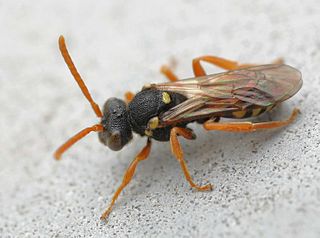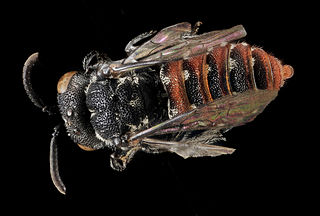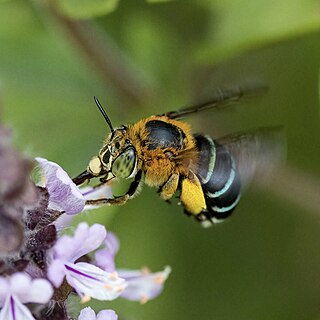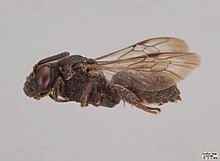
The term cuckoo bee is used for a variety of different bee lineages which have evolved the kleptoparasitic behaviour of laying their eggs in the nests of other bees, reminiscent of the behavior of cuckoo birds. The name is perhaps best applied to the apid subfamily Nomadinae, but is sometimes used in Europe to mean bumblebees (Bombus) in the subgenus Psithyrus. Females of cuckoo bees are easy to recognize in almost all cases, as they lack pollen-collecting structures and do not construct their own nests. They often have reduced body hair, abnormally thick and/or heavily sculptured exoskeleton, and saber-like mandibles, although this is not universally true; other less visible changes are also common.

Nomadinae is a subfamily of bees in the family Apidae. They are known commonly as cuckoo bees.

Schwarziana is a relatively small genus of South American stingless bees. Like other stingless bees, Schwarziana are eusocial, with large colonies primarily composed of workers and one queen. Unusually for stingless bees, colonies are formed in underground chambers rather than in tree cavities. Workers are approximately 6.5mm long

The Melectini are a tribe of medium- to large-sized cuckoo bees in the family Apidae, found essentially worldwide. They are brood parasites of the related typical digger bees (Anthophorini) and occasionally visit flowers.

The Protepeolini are a tribe of cuckoo bees in the family Apidae, containing only one genus, Leiopodus.

Euglossa decorata is a species of euglossine bee.
Biastes fulviventris is a species of cuckoo bee in the family Apidae, in the subgenus Neopasites.

Neolarrini is a tribe of cuckoo bees in the family Apidae. There are 5 genera and about 40 described species in Neolarrini, which includes the genera and species formerly included in the deprecated tribes Biastini and Townsendiellini.

Holcopasites calliopsidis is a species of cuckoo bee in the genus Holcopasites in the family Apidae. It is found from Mexico to Canada.

Holcopasites is a genus of cuckoo bees in the family Apidae. There are at least 20 described species in Holcopasites.

Brachymelecta is a genus of cuckoo bees in the family Apidae, formerly known by the name Xeromelecta.

Epeolus mesillae is a species of cuckoo bee in the family Apidae.

Brachynomada is a genus of cuckoo bees in the family Apidae. There are about 16 described species in Brachynomada.

Brachynomadini is a tribe of cuckoo bees in the family Apidae. There are at least 5 genera and 20 described species in Brachynomadini.
Oreopasites is a genus of cuckoo bees in the family Apidae. There are about 11 described species in Oreopasites.
Biastes mojavensis is a species of cuckoo bee in the family Apidae, in the subgenus Neopasites. It is found in North America.

Paranomada is a genus of cuckoo bees in the family Apidae. There are at least three described species in Paranomada.

Peponapis is a genus of bees belonging to the family Apidae.

Zonamegilla is a large subgenus of the bee genus Amegilla. Species of this subgenus can be found throughout Australia, Europe and Asia. Some Zonamegilla are commonly referred to as blue-banded bees; however, the abdominal bands can also be orange, green, white or yellow, depending on the species.














